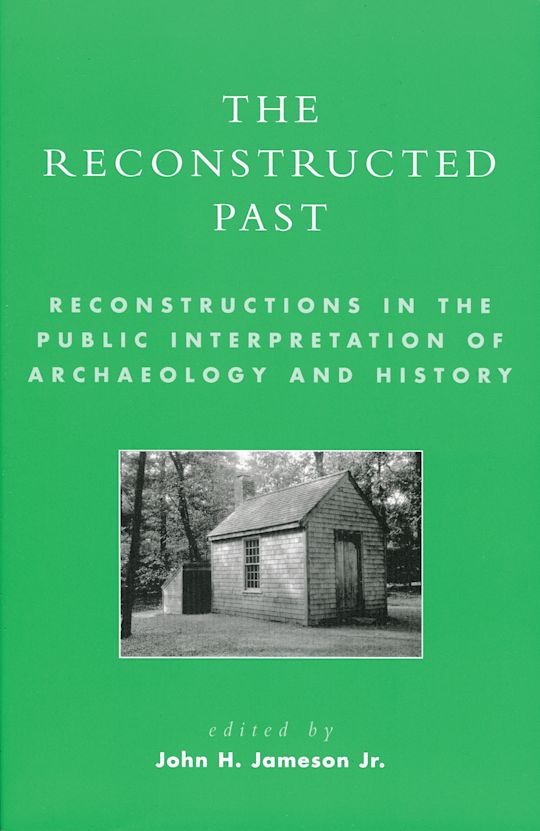- Home
- ACADEMIC
- Archaeology
- Archaeology - Other
- The Reconstructed Past
The Reconstructed Past
Reconstructions in the Public Interpretation of Archaeology and History
John H. Jameson Jr. (Anthology Editor) , Marion Blockley (Contributor) , Marley R. Brown III (Contributor) , Karen A. Brush (Contributor) , Edward A. Chappell (Contributor) , Robert Daniels-Dwyer (Contributor) , Joe Distretti (Contributor) , Peter J. Fowler (Contributor) , Bruce W. Fry (Contributor) , John H. Jameson (Contributor) , Ann E. Killebrew (Contributor) , Carl Kuttruff (Contributor) , Donald W. Linebaugh (Contributor) , Barry Mackintosh (Contributor) , Susan Mills (Contributor) , Haryold Mytum (Contributor) , Lynn A. Neal (Contributor) , Vergil E. Noble (Contributor) , Dwight Pitcaithley (Contributor) , Rodd L. Wheaton (Contributor) , Esther C. White (Contributor) , Ronald F. Williamson (Contributor)
The Reconstructed Past
Reconstructions in the Public Interpretation of Archaeology and History
John H. Jameson Jr. (Anthology Editor) , Marion Blockley (Contributor) , Marley R. Brown III (Contributor) , Karen A. Brush (Contributor) , Edward A. Chappell (Contributor) , Robert Daniels-Dwyer (Contributor) , Joe Distretti (Contributor) , Peter J. Fowler (Contributor) , Bruce W. Fry (Contributor) , John H. Jameson (Contributor) , Ann E. Killebrew (Contributor) , Carl Kuttruff (Contributor) , Donald W. Linebaugh (Contributor) , Barry Mackintosh (Contributor) , Susan Mills (Contributor) , Haryold Mytum (Contributor) , Lynn A. Neal (Contributor) , Vergil E. Noble (Contributor) , Dwight Pitcaithley (Contributor) , Rodd L. Wheaton (Contributor) , Esther C. White (Contributor) , Ronald F. Williamson (Contributor)
You must sign in to add this item to your wishlist. Please sign in or create an account
Description
To reconstruct or not to reconstruct? That is the question facing many agencies and site managers throughout the world. While reconstructed sites provide a three-dimensional pedagogic environment in which visitors can acquire a heightened sense of the past, an ethical conflict emerges when on-site reconstructions and restorations contribute to the damage or destruction of the original archaeological record. The case studies in this volume contribute to the ongoing debates between data and material authenticity and educational and interpretive value of reconstructions. Discussing diverse reconstruction sites from the Golan Region to Colonial Williamsburg, the authors present worldwide examples that have been affected by agency policies, divergent presentation philosophies, and political and economic realities.
Table of Contents
Part 2 Chapter 1: Introduction
Part 3 Part One: Definitions and History
Chapter 4 Chapter 2: Walden Pond and Beyond: The Restoration Archaeology of Roland Wells Robbins
Chapter 5 Chapter 3: Colonial Williamsburg: Archaeological Authenticity and Changing Philosophies
Chapter 6 Chapter 4: National Park Service Reconstruction Policy and Practice
Part 7 Part Two: Measuring Effectiveness for Interpretation and Site Management
Chapter 8 Chapter 5: George Washington's Blacksmith Shop
Chapter 9 Chapter 6: Castell Henllys Iron Age Fort, Wales
Chapter 10 Chapter 7: Ancient Qasrin Synagogue and Village, Golan Region
Chapter 11 Chapter 8: The Iroquian Longhouse
Chapter 12 Chapter 9: Fort Loudoun, Tennessee
Chapter 13 Chapter 10: The Ironbridge Gorge, England
Chapter 14 Chapter 11: Fortress of Louisbourg, Canada
Chapter 15 Chapter 12: Bent's Old Fort and Fort Union Trading Post
Chapter 16 Chapter 13: A Case for Preservation-in-place at Homolovi Ruins State Park, Arizona
Part 17 Part Three: Virtual Reconstructions
Chapter 18 Chapter 14: Modeling Amarna: Computer Reconstructions of an Egyptian Palace
Chapter 19 Chapter 15: From Photo-Realism to Integrated Reconstruction in Buildings Archaeology
Part 20 Part Four: The Future of Reconstruction
Chapter 21 Chapter 16: The Value of Reconstructions: An Archaeologist's Perspective
Product details
| Published | Jan 13 2004 |
|---|---|
| Format | Ebook (Epub & Mobi) |
| Edition | 1st |
| Extent | 320 |
| ISBN | 9780759115897 |
| Imprint | AltaMira Press |
| Publisher | Bloomsbury Publishing |
About the contributors
Reviews
-
The Reconstructed Past is a very affordable reference, which will be of great interest to public archaeologists, historical interpreters, historic site managers, and anyone involved in reconstructions.
David J. Cooper, Grand Portage National Monument, National Park Service
-
For anyone who works in the fields of archaeology, historic presentation, and public education, this book has useful lessons on the benefits and pitfalls associated with reconstructions.
Canadian Journal of Archaeology
-
The Reconstructed Past is a thoughtful, varied collection of articles, and collectively, they address many of the preservation issues which must underlie all of public archaeology.
Archaeology.About.Com
-
Because this book is written without jargon and tells behind-the-scenes stories about people and places, The Reconstructed Past will benefit both students and professionals. The case studies and the history of applied archeology are appropriate for university or college classrooms, particularly method and theory classes. The book's themese would also interest professionals making decisions about site interpretation. The provocative case studies illuminate the dilemma of reconstruction.
Crm: The Journal Of Heritage Stewardship
-
While this entire volume is engaging, two contributions are of particular interest to those involved with industrial archaeology. Linebaugh's article on Roland Wells Robbins gives a very in-depth and fascinating view of the reconstruction of the Saugus Iron Works, including plans and excavation photos from original fieldwork. The article by Blockley is devoted to the pragmatic and ethical complexities of the reconstruction and preservation of large-scale industrial sites.
Industrial Archeology
-
If you wanted to put a single volume in front of a beginning public historian or archaeologist about the perils of a singular aspect of their chosen professions, this collection of articles would be a good start.
Historic Environment


































